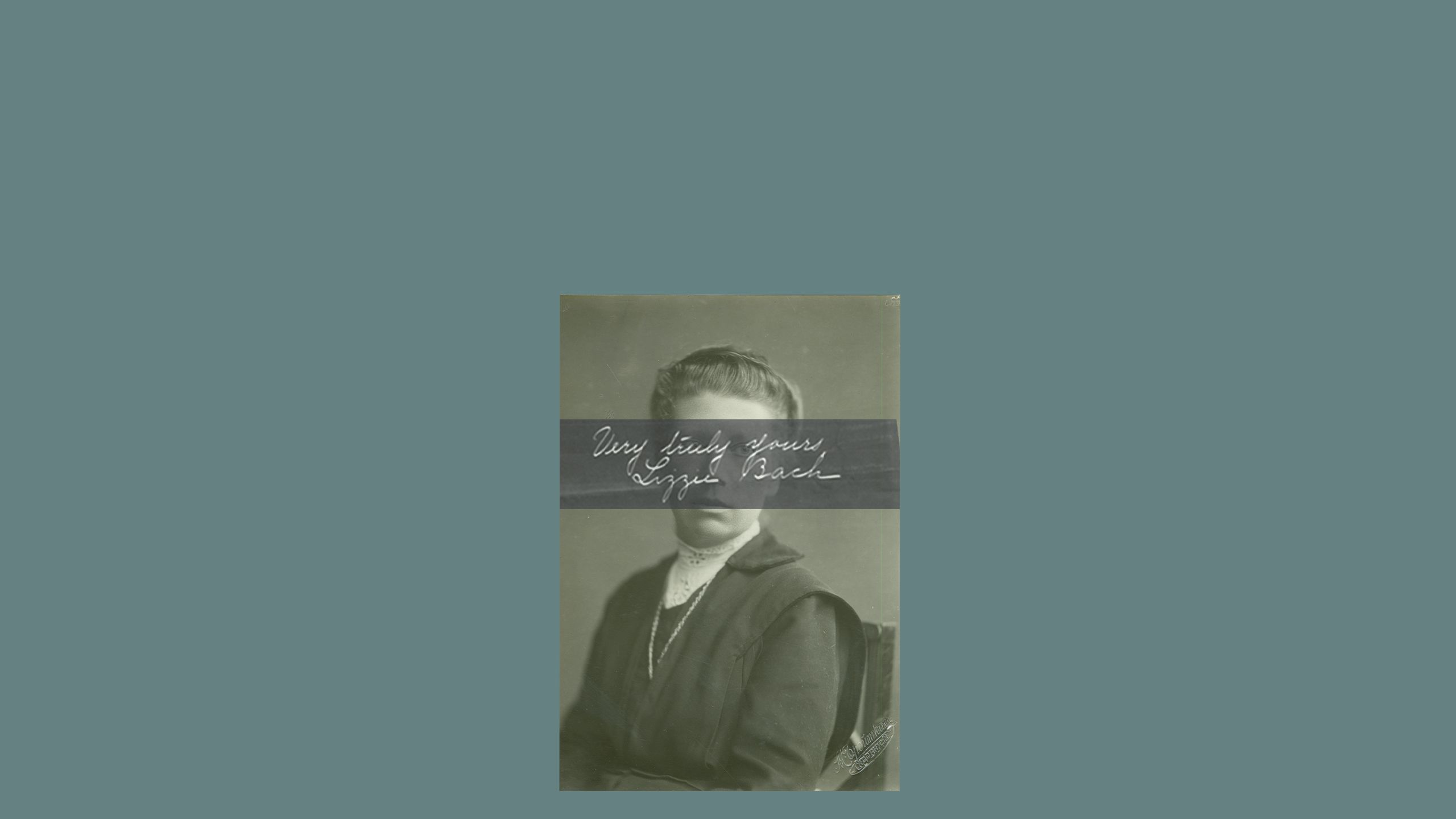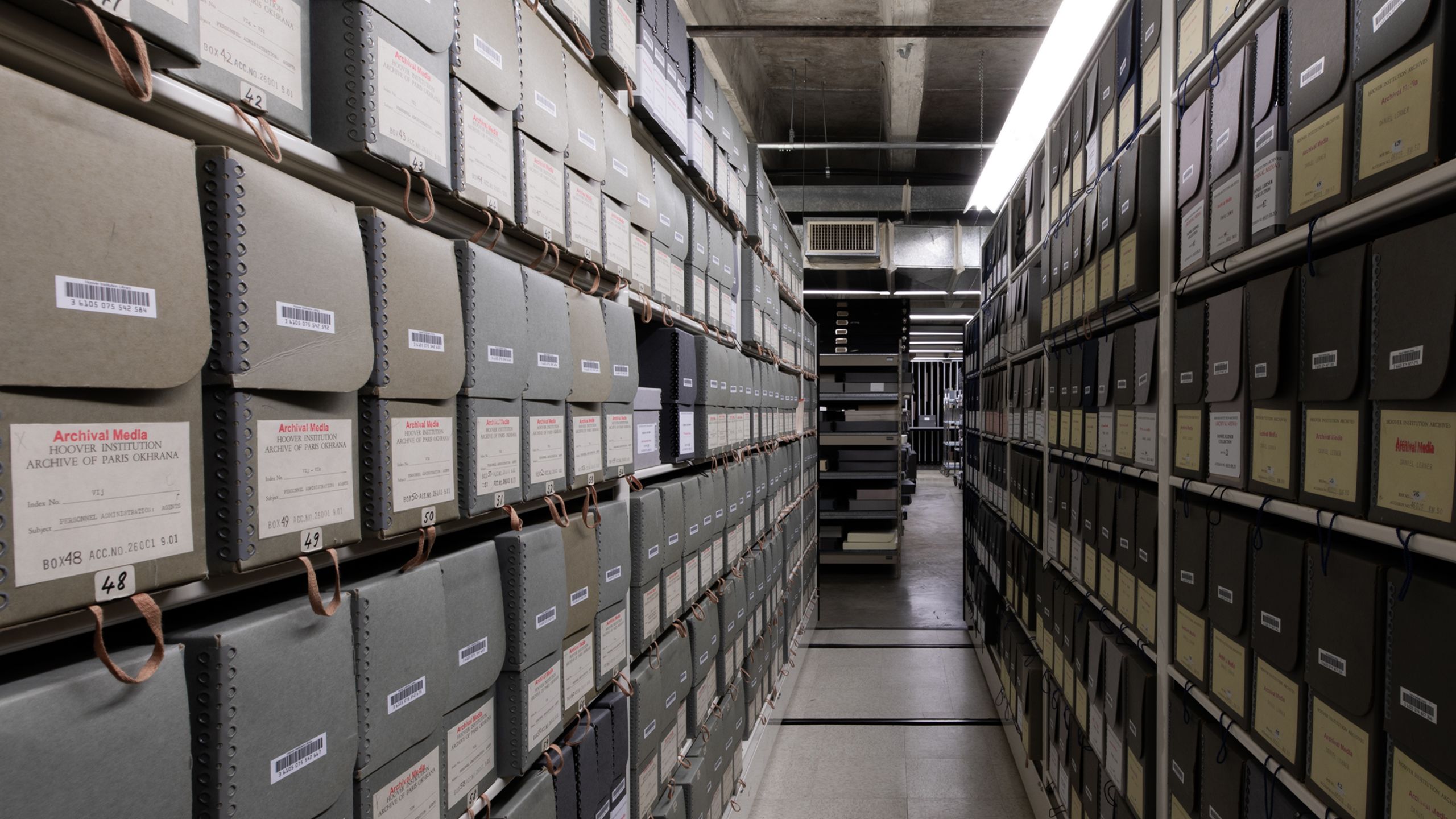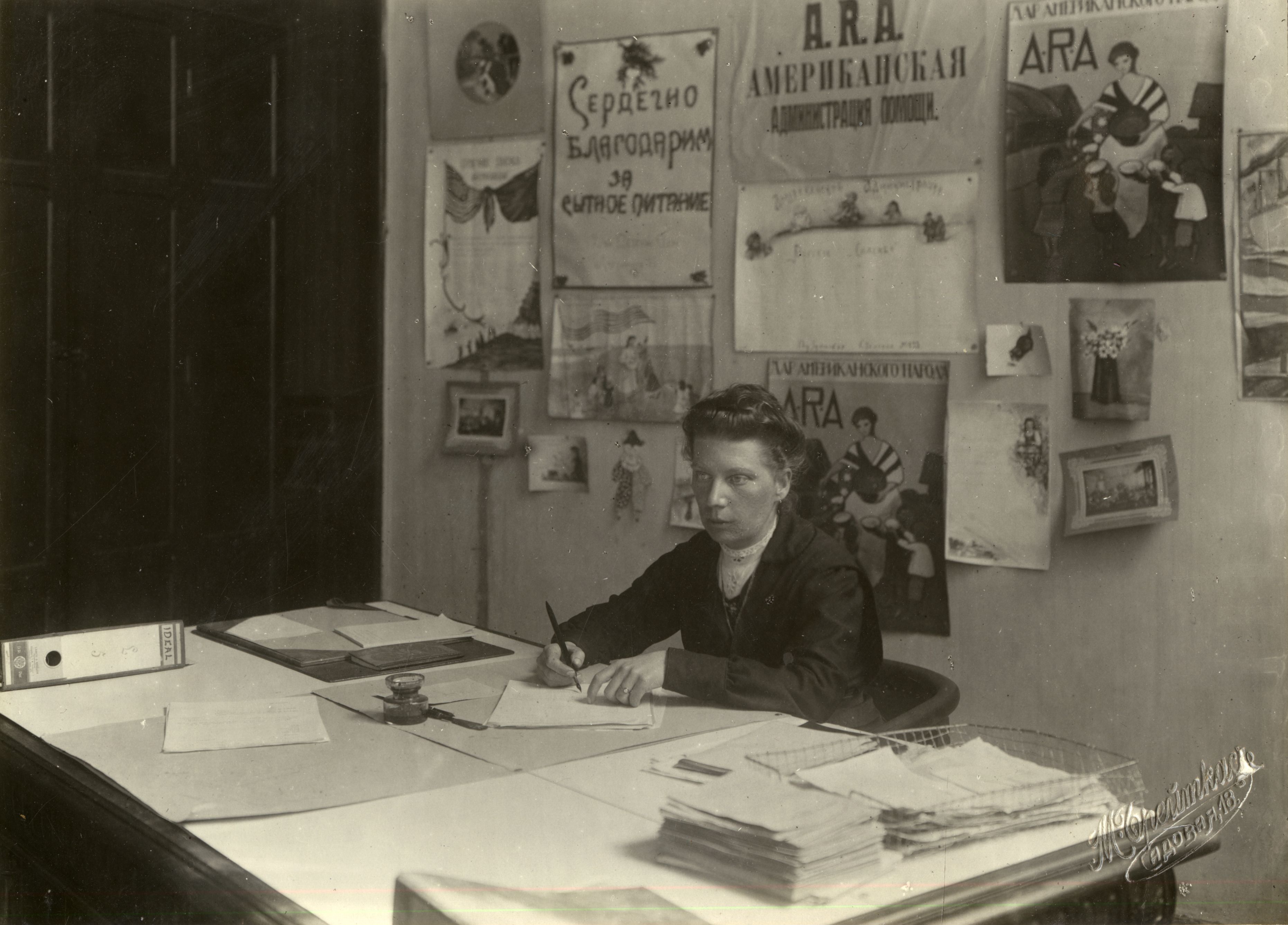Forgetting Lizzie Bach
Pennsylvania to Petrograd . . . and Back?

During the 2021–22 academic year, the Center for Russian, East European and Eurasian Studies (CREEES) at Stanford University sponsored a directed reading course based at the Hoover Institution Library & Archives. It was taught by Hoover research fellow Bertrand Patenaude, who also guest curated the exhibition Bread + Medicine: Saving Lives in a Time of Famine. The students researched the American Relief Administration Russian operations and chose unique topics for their final research papers. These papers are now presented as digital stories and are part of the Bread + Medicine online exhibition.
“The A.R.A. cannot only be considered a charity job nor as a business affair but as an immense human task full of the most human elements all contributing to the relief and upheaval of poor unfortunate Russia.”
—Lizzie Bach, “Child Feeding Report” [May 1923]
The American Relief Administration (ARA) Russian operational records at the Hoover Institution Library & Archives are an extraordinary primary source. With more than five hundred fifty manuscript boxes containing correspondence, official documents, photographs, and original artworks, the collection seems to register everything imaginable about the ARA’s activities in Soviet Russia. These files also contain a variety of singular curiosities, from a series of paintings depicting the famine’s destructive effects on people, culminating in cannibalism, to letters reporting the futile attempts of a few Americans to send over their house cats so they could join the hunt for the vermin plaguing Russia’s crops. Through these extensive records, we get a clear picture of how aid workers ran day-to-day operations, how these efforts evolved over time, and the program's impact on the beneficiaries. In fact, the documentation is so detailed that one can trace the experiences of individual relief workers during their time in Soviet Russia.
Background image: View of the closed stacks at the Hoover Institution Library & Archives, Stanford University, 2022.

Curiously, this does not apply to Lizzie Bach, the only American woman to fill a regular staff position with the ARA. Bach was the director of the ARA’s first kitchen in Soviet Russia, located in Soviet School No. 27, at 108 Moika River Embankment in Petrograd (the former and future St. Petersburg). This kitchen was seminal, serving not only as a place of lifesaving sustenance but also as the training ground for other ARA personnel who went on to become directors and controllers of their own kitchens.
Despite the significance of Bach’s work and her unique status as the ARA’s lone American female staff member in Soviet Russia (other than a few women who were hired by the ARA to do short-term publicity work there), Bach goes unmentioned in the official ARA history, published in 1927, where her name was omitted from the extensive list of Americans who served with the ARA Russia mission. She appears several times in the ARA’s photographic record, but there is precious little documentation, in the Hoover Archives or anywhere else, about her life before the ARA, and there seems to be nothing at all about what became of her after it. And so, among those hundreds of boxes and thousands of folders, references to Bach are very rare: just a few pieces of correspondence, photographs, and a couple of indirect references to her.
Miss Lizzie Bach at her desk, ARA kitchen, Petrograd, circa 1922. Photographed by M. Breitkas. Belgian-American Educational Foundation Records, Herbert Hoover Presidential Library and Museum
Miss Lizzie Bach at her desk, ARA kitchen, Petrograd, circa 1922. Photographed by M. Breitkas. Belgian-American Educational Foundation Records, Herbert Hoover Presidential Library and Museum
One of the more illuminating references is a letter from Carlton Bowden, the American supervisor for the Petrograd district, to the ARA’s London headquarters, dated September 18, 1921, not long after the Americans arrived in the city.
“We were fortunate to find an American woman, Miss Bach, to direct the first kitchen. It has been a success in every way.”
How they “found” an American woman in postrevolutionary Russia is a fascinating story. Bach was a native of Cornwall, Pennsylvania, who traveled extensively in Europe after her parents’ passing. In 1913, she moved to Russia to serve as governess for a “wealthy orphan boy.” The outbreak of the First World War would have made it difficult, if not impossible, for her to leave Russia. Then came the Russian Revolution of 1917. Rather than flee the country, Bach stayed with her charge, maintaining a low profile by speaking only Russian in public. When the ARA arrived in the first days of September 1921, Bach decided to sign on with the mission. A local newspaper back in Pennsylvania quoted her as saying: “So, if I could help my own people in their service to the starving people of Russia, I was glad to stay here a while longer.”
Clipping from the Lebanon Daily News (Lebanon, Pennsylvania), July 20, 1922.
Clipping from the Lebanon Daily News (Lebanon, Pennsylvania), July 20, 1922.
Bach was a godsend for the American relief workers. She knew the terrain, the language, and the culture, which meant she knew how to get things done in a place notorious for inertia and endless red tape. Within six weeks of establishing the first kitchen, as ARA operations in Petrograd rapidly expanded, Bach was overseeing the management of nearly a hundred ARA kitchens serving daily meals to a total of fifty thousand children. The number of kitchens under her direction would continue to expand and come to include ARA dining rooms at refugee centers and in hospitals. Eventually Bach was named head of the Petrograd ARA’s Inspection Division. Her effectiveness in the job debunked the assumption held by the chief officers of the ARA in New York and London that Russia was no place for a woman. That point of view is soundly contradicted by the archival photos of Bach with the rest of the local kitchen managers, a determined-looking team dedicated to their work.
Bach in her office (at center of desk) among the managers of the ARA's kitchen in Petrograd, 1922. Digital Record
Bach in her office (at center of desk) among the managers of the ARA's kitchen in Petrograd, 1922. Digital Record
So, if you were a kid in Petrograd, what sort of dining experience could you expect at one of the kitchens overseen by Bach? You would be served what the ARA called a “supplementary” meal. Exact menus for these meals would vary depending on the availability of food products, but they would all meet certain nutritional requirements, which depended on the age of the child. These meals, typically served in the afternoon and consisting of white bread, corn grits, rice, fats, sugar, canned milk, and cocoa, became very popular with the children. Cocoa was, for some, an acquired taste, as Bach recounts:
“It is interesting to state that these refugees did not like cocoa at first, but after some time, they always asked for a second ration.”
The stress involved in managing kitchens for a starving population was magnified by the threat of contagious disease, especially during the first winter of ARA operations. Bach records in December 1921, “the floors of the dining rooms were covered with lice and many of the personnel died, having caught the typhus.”
ARA kitchen (in the former palace of the Grand Duchess Olga Alexandrovna), Petrograd, circa 1922. Variant Digital Record
ARA kitchen (in the former palace of the Grand Duchess Olga Alexandrovna), Petrograd, circa 1922. Variant Digital Record
In the summer of 1922, the ARA’s dining rooms were principal sites for its vaccination campaign. For those who might be skeptical, or fearful, of being vaccinated, the ARA possessed the ultimate leverage in the form of food. If you wanted your meal, you had to get your shot. Thus, the several dozen ARA kitchen managers working under Bach’s direction played a significant role in the success of the American vaccination campaign in Petrograd.
At center is Lizzie Bach (wearing fur stole) with the ARA kitchen managers, Petrograd, circa 1922.
A report Bach authored in spring 1923 on child feeding sheds some light on her work and her character. There she describes the miserable state of health of Petrograd’s children and the work involved in rehabilitating them. As controller of the Childfeeding Division in Petrograd, Bach dealt directly with both children and adults suffering from the famine:
“The task of the controllers … of combatting with the undisciplined, excitable people who did not want to obey our instructions, and acknowledge our system of work, was very hard.”
ARA kitchen for refugees, Petrograd, circa 1922. Digital Record
ARA kitchen for refugees, Petrograd, circa 1922. Digital Record
With the proper distribution of food strictly enforced, the issue of “control” and the enforcement of rules were critical to the success of ARA operations. In order to make sure food was consumed by the intended beneficiary, children were not allowed to take food home or have their parents accompany them into the dining room—neither regulation being popular with the beneficiaries. These policies, Bach says, created “much trouble and disorder.” Children being children, they also required constant monitoring in the dining hall. Moreover, the local Russian kitchen staff members, themselves hungry and demoralized, were prone to thievery and had to be monitored. In Bach’s own words, “The strict methods of the ARA saved us in a country that in the course of four years reached the limit of moral and physical exhaustion.”
Children at ARA kitchens (left in Ukraine, right in Moscow) with rations and required ration cards, 1922. Digital Record (left). Digital Record (right).
Children at ARA kitchens (left in Ukraine, right in Moscow) with rations and required ration cards, 1922. Digital Record (left). Digital Record (right).
To Bach, the ARA was not only saving the lives of the Russian people but restoring their integrity as well. Whereas she initially described some of the famine-stricken children as resembling animals more than people, she would go on to say that within three months, so vast was the improvement in their condition, it was impossible to recognize these children as the same. “One felt the good influence of the ARA and the children themselves tried to keep order. They loved the dining room and felt happy and comfortable there. I asked a little chap pointing to the portrait of Mr. Hoover framed in leaves ‘Who is that’ and he answered ‘That is the good father of all the poor children.’”
Children at an ARA kitchen, Petrograd, circa 1922. Digital Record
Children at an ARA kitchen, Petrograd, circa 1922. Digital Record
As an American woman in Petrograd, Lizzie Bach filled a critical role for the ARA workers, who relied on her for her knowledge of the city and its people. Yet, the unusual way Bach came to be hired by the ARA—in addition, perhaps, to the fact that she was a woman—is likely the main reason why she left such a small footprint in the ARA’s documentation and therefore in accounts of the mission. Having joined the ARA while in Russia, Bach did not have an application like other American relief workers, and she seems to have stayed within Petrograd the entire time, further reducing her paper trail. In a December 1922 letter to an ARA director, she laments the lack of recognition and the fact that she is being lumped in with the local staff members, and requests that she be “taken out of the ranks of the ‘natives’ and put on the staff of Americans.”
Letter from Lizzie Bach addressed to Walter Lyman Brown, Director General, ARA New York, December 23, 1922. ARA Russian operational records, Box 76, Folder 1. This letter is partially misaddressed, as Brown was the ARA's director for Europe and based in London. Edgar Rickard was the director general of the ARA based in New York and the intended/actual recipient.
Letter from Lizzie Bach addressed to Walter Lyman Brown, Director General, ARA New York, December 23, 1922. ARA Russian operational records, Box 76, Folder 1. This letter is partially misaddressed, as Brown was the ARA's director for Europe and based in London. Edgar Rickard was the director general of the ARA based in New York and the intended/actual recipient.
One person who recognized the potential appeal of a story about Bach’s background and her contributions to the ARA was Bessie Beatty, a onetime radical journalist from Los Angeles and witness to the Russian Revolution who encountered Bach in Petrograd. Beatty intended to write a feature article about Bach for an American magazine, and after leaving Soviet Russia she requested that the ARA arrange for studio photographs of Bach to be taken in Petrograd so she could use them as illustrations for her article. Such a profile would certainly have brought Bach’s biography to vivid life, but unfortunately, if the article was written, it seems never to have been published. The portrait photographs of Bach ended up in a folder of Bessie Beatty material housed in the Herbert Hoover Presidential Library in West Branch, Iowa.
Miss Lizzie Bach, Petrograd, circa 1922. Photographed by M. Breitkas. Belgian-American Educational Foundation Records, Herbert Hoover Presidential Library and Museum
Miss Lizzie Bach, Petrograd, circa 1922. Photographed by M. Breitkas. Belgian-American Educational Foundation Records, Herbert Hoover Presidential Library and Museum
In July 1922, near the halfway point of the ARA’s two-year mission, Bach was quoted in a local Pennsylvania newspaper as saying, “My chief desire in life used to be to travel, but now I envy those who sit quietly at home in America.” There is no firm evidence in the vast ARA records that Bach left Soviet Russia after the mission came to an end in July 1923. Did she return to her native Pennsylvania, as it appears she intended to do? This absence of documentation may be a source of frustration for the curious reader. But it may also contain a silver lining. Bach’s fragmentary and incomplete story is an opportunity to be enthralled by her mysterious history and to recognize that an interesting life full of kind and meaningful service is even more common than the records show. We’re left with an unfinished story, with only our own imagination, or our wits, to fill in the gaps.
Lizzie Bach’s Petrograd
План г. Петрограда: исправленный на 1918 г. Издание Издательства Маяк. Екатерингофское Печатное Дело.
Plan of the city of Petrograd: revised for 1918. Edition of the Mayak Publishing House. Ekateringof Printing.
Courtesy of the David Rumsey Historical Map Collection, Stanford University
The First ARA Kitchen
The ARA kitchen set up in Soviet School No. 27, at 108 Moika River Embankment in Petrograd, was the first one to open in all of Soviet Russia.
ARA Headquarters, Petrograd
Lizzie Bach was likely on site when the first kitchen opened but had her office at ARA Headquarters, located at Morskaya 40 in Petrograd (the street is known today as Bolshaya Morskaya Street).
Obukhovskaya Hospital
There were dozens of kitchens opened throughout Petrograd by the ARA, including in hospitals such as the Obukhovskaya Hospital at 106 Fontanka Embankment. Founded here in 1779, the hospital remains in operation today.
ARA kitchen at the Obukhovskaya hospital in Petrograd. Digital Record. Two favorite menu items are visible here: freshly baked white rolls and canned milk.
ARA kitchen at the Obukhovskaya hospital in Petrograd. Digital Record. Two favorite menu items are visible here: freshly baked white rolls and canned milk.
Gagarin Street Kitchen
The ARA required those who were fed at their kitchens to be vaccinated, leading to the sites themselves being used for injections. This was included in the work of the ARA kitchen directresses, led by Lizzie Bach.
Typhoid inoculation, Petrograd, 1922. Digital Record
Typhoid inoculation, Petrograd, 1922. Digital Record
Inoculation for Cholera, 1922. Photographed by M. Breitkas. Digital Record
Inoculation for Cholera, 1922. Photographed by M. Breitkas. Digital Record
The two photographs taken at this kitchen identify children being vaccinated for typhoid in one and cholera in the other, though seemingly taken at the same time. This is because both diseases were prevented with the tetra-vaccine.
About the Author
Daniel Wu is a Stanford senior majoring in history with a minor in creative writing. Daniel, who is from Kauai, Hawaii, works part time at the Hoover Library & Archives and, when he’s back home, volunteers at the Kauai Historical Society. In his free time, he likes to cook, go longboarding, read Junji Ito, and hike with his dog.
This digital story is a component of the Bread + Medicine: Saving Lives in a Time of Famine online exhibition, launched in conjunction with the eponymous exhibition presented by the Hoover Institution Library & Archives, curated by Hoover Research Fellow Bertrand Patenaude, and displayed at Hoover Tower at Stanford University from Sept. 19, 2022 - May 21, 2023.
Unless otherwise noted, all material comes from the American Relief Administration Russian operational records archival collection at the Hoover Institution Library & Archives.
The Hoover Institution Library & Archives has placed copies of these works online for educational and research purposes. If you would like to use any of these works, you are responsible for making your own legal assessment and securing any necessary permission. If you have questions about this resource or have concerns about the inclusion of an item, please contact the Hoover exhibits team.
Contact Us
For more information about rights and permissions please visit
,https://www.hoover.org/library-archives/collections/get-help/rights-and-permissions.
© 2022 by the Board of Trustees of Leland Stanford Junior University.















